|
The Fiat Panda
is used as a showcase model within Fiat Auto for product
life-cycle management, referred to by management as the “Panda
Lesson”. Ever since its world preview at the Geneva 2003
Salon, where the versatile and spacious small car still wore
the “Gingo” badge, public demand has been high. So much
so that production at the Polish Tychy plant passed the
manufacturing milestone of 500,000 earlier in October this
year.
Although ordained primarily for the European markets, the
Fiat Panda is also sold in various Asian markets including
Malaysia, Taiwan and Japan, as well as exotic locations
including Martinque. Its success in the A-segment category
within Europe, and more notably within the Italian market,
has been spearheaded by various awards including the
prestigious “European Car of the year 2004” accolade.
The Fiat Panda was the first A-segment car to win the award,
and to date no competing A-segment car has taken the title.
Demand has spawned various new variations on the original
Panda theme, including the 2004 4x4 which has exceptional
off-road ability, partly due to its small size and light
weight. The simple viscous coupling all-wheel-drive system
makes the Panda 4x4 much more manoeuvrable and agile, and
the perfect solution for the driver who drives in poor
traction conditions, including ice and steep gradients.
More recently, the stylish Fiat Panda Alessi was introduced
at the Tokyo motorshow, available for sale in Europe from
January 2006, characterised externally by its aesthetic and
chromatic touches on the front grille, door panels and wheelarch trim, as well as new bumpers and wheel trim. 2006
will also see two other additions to the Fiat Panda family,
including the Fiat Panda SUV, and a brand new
environmentally friendly CNG Compressed Natural Gas engine
option.
The Panda SUV will be showcased at the Bologna motorshow
next month, and has already been captured on camera. Its
rugged off-road look has evolved from the Fiat Simba
concept car that was displayed at the 2002 Bologna Salon and Panda SUV concept car from Geneva 2003. The production car is
no phoney deception, with the car being based on the
highly capable Panda 4x4, a car which has even surprised
Fiat engineers with its performance.
Availability of the 1.3 litre Multijet Diesel engine on 4x4 model Fiat Panda’s may also be expanded throughout Europe and other markets, with many countries still offering only the petrol engines.
|
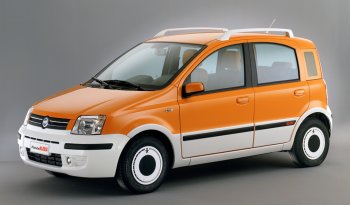
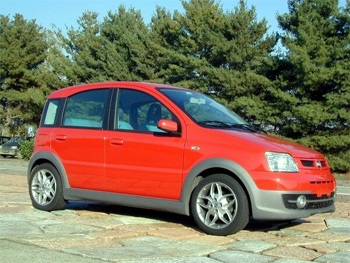
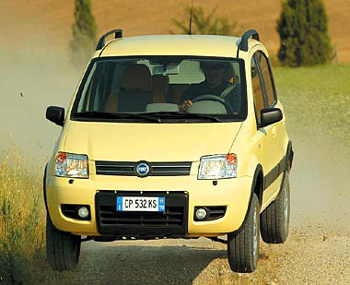 |
|
The
Fiat Panda represents the pinnacle of life-cycle
management within Fiat Auto. The Abarth prototype (centre)
will share many styling
elements with the 2007 Panda Sports |
|
|
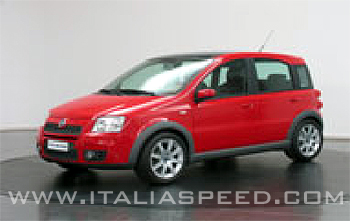
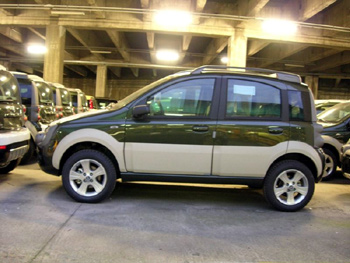
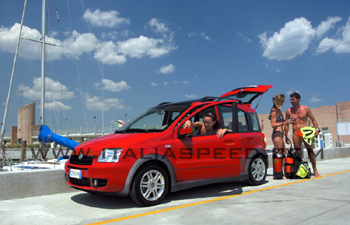 |
|
The Fiat Panda Sports as
pictured in an official photograph from Fiat (top),
will be available during 2007. The 2006 model
year Fiat SUV will be presented at Bologna early next month.
 |
|
|
2007 will see a brand new Panda “Sports”
version launched, although the exact specifications have not yet been
revealed. It is rumoured, however, that a sports diesel
engine will be available. Visually, the Sports version will
be inspired by the Panda Abarth prototype, and will be
feature a lightly modified front end with the grille
positioned lower in the face to provide a more sporty
stance.
Dark gray wheel arch extensions, under bumper treatment, and
sideskirts will also feature, whilst the utilitarian black
protection strips will no longer appear on the bumpers and
doors. The door handles and exterior mirrors will also be finished in
body colour, while the new rear light modules from the Fiat
Panda SUV will be presented, although these will be finished
off in the body colour. A leaked image of the new modek also shows the car to
have mildly lowered suspension, and brand-new 8-spoke alloy
wheels.
A
full facelift for the Panda will appear in 2008, followed by a
extended batch of special
series models. The life-cycle management of the Fiat Panda will
continue until 2010, when a run of series will prepare the
way for
the replacement model – the Fiat Panda II.
In
the meantime, development is also underway on the brand new
Fiat 500, in cooperation with Ford, which will use the Fiat
Panda as a basis. The Fiat Panda serves as an excellent
starting point, with its foundation as a ‘robust’
project leading to it having remarkable torsional rigidity
characteristics. The bodywork of the Panda has a torsional
rigidity of 70,500 Nm/rad, which is amongst the best in the
category. The joint Ford Ka / Fiat 500 project will also
make use of Fiat engines, which offer top class fuel
consumption and performance. The 1.2 litre petrol engine,
for example, has been engineered for high torque at low rpm,
and has gear ratios specifically calibrated for lower fuel
consumption. It is an engine that simply ‘chugs’ on in
any gear, with a combined cycle indicating a fuel
consumption of only 5.6 litres per 100 kilometres, and has
proved its strength in the 4x4 models.
by Paddy Granger
|
|
|
|
![]()
![]()